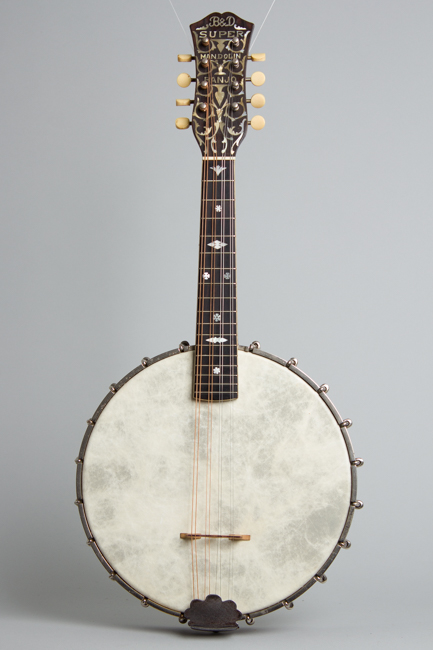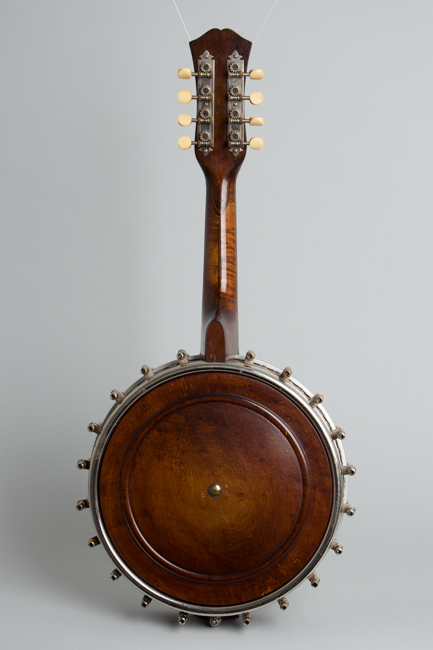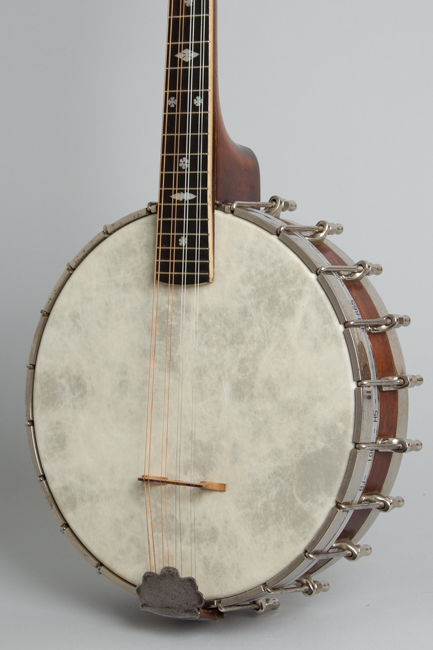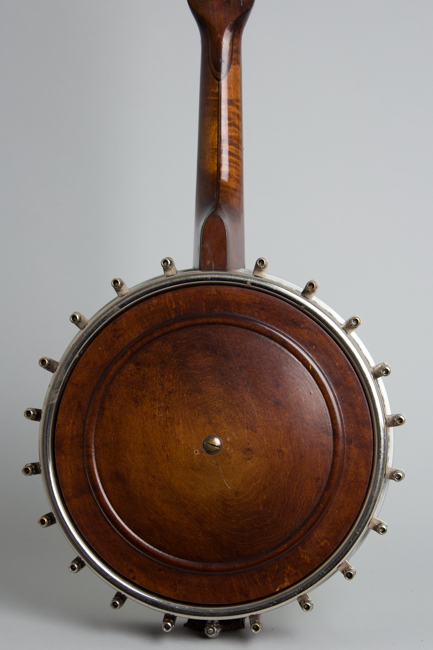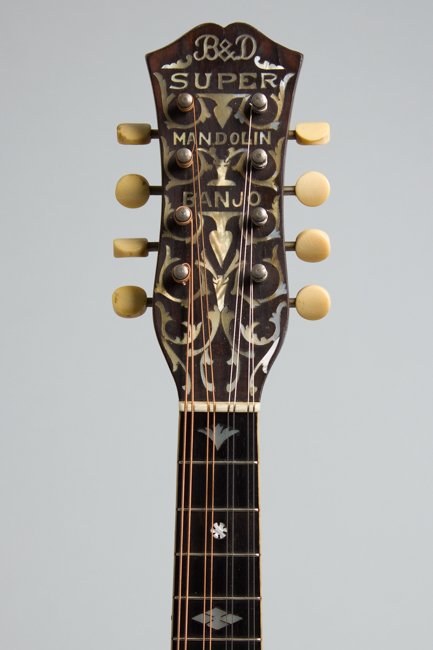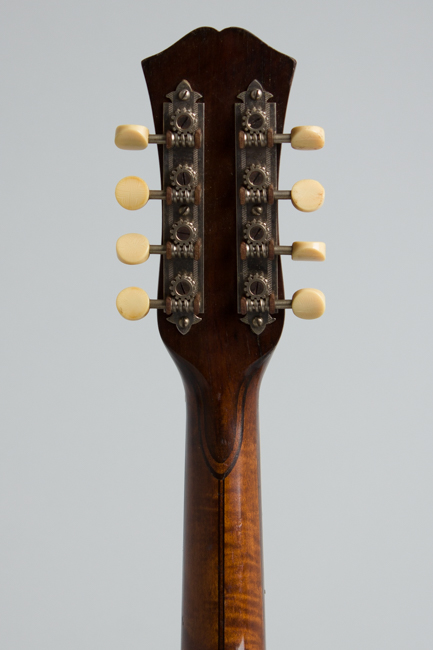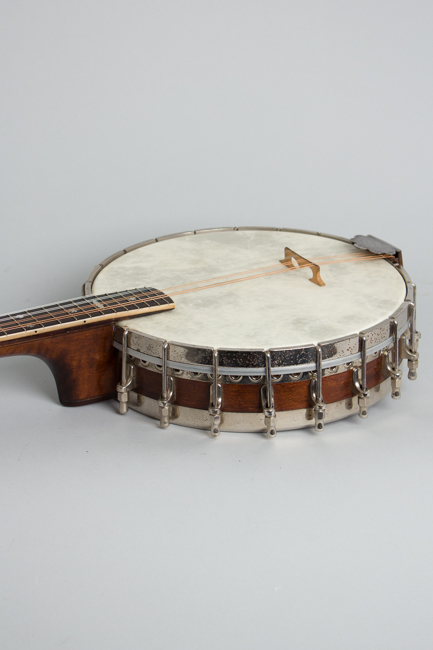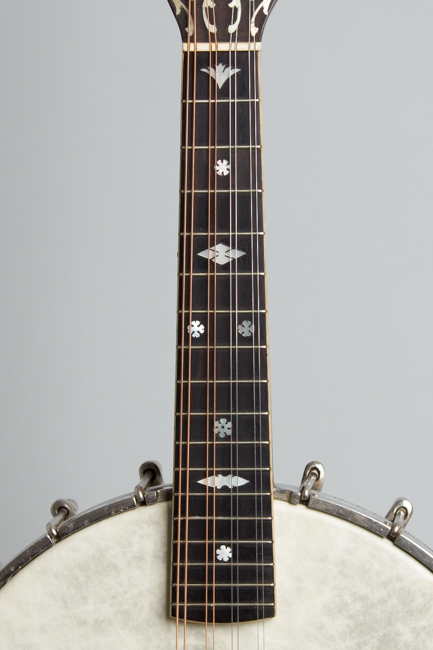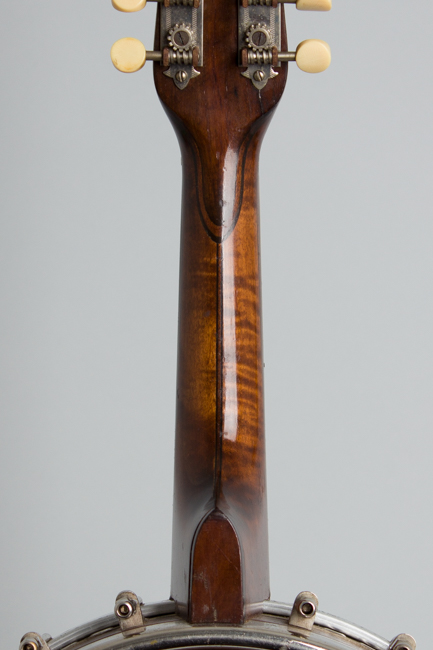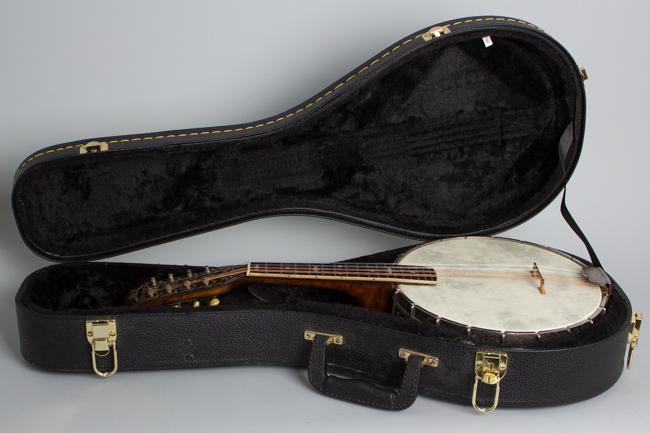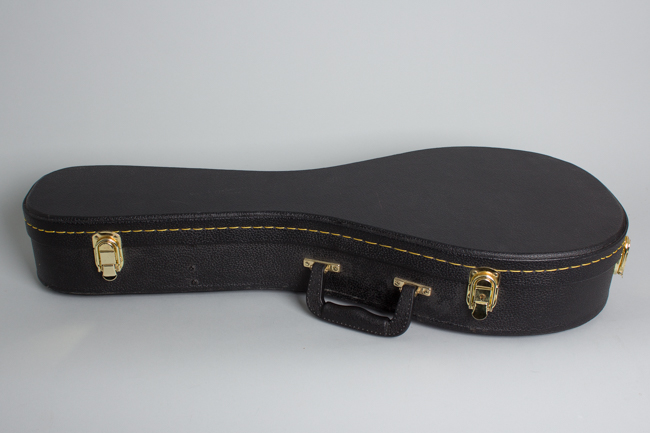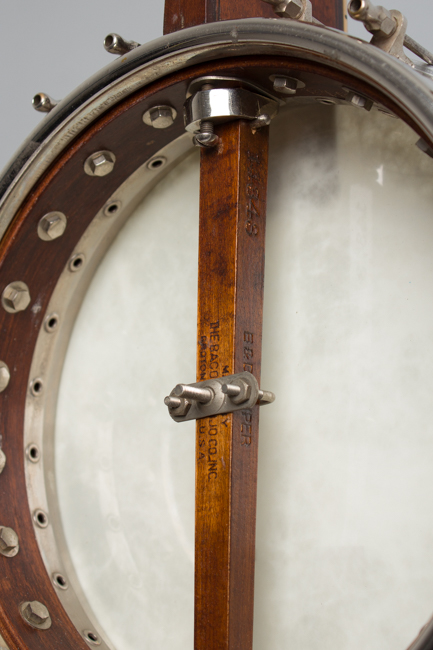Bacon & Day Super Style A Mandolin Banjo (1924)
This item has been sold.
Item # 10561
Prices subject to change without notice.
Bacon & Day Super Style A Model Mandolin Banjo (1924), made in Groton CT, serial # 14343, shaded maple finish, laminated maple neck and rim, ebony fingerboard, black tolex hard shell case.
The 8-string mandolin/banjo is one of the rarer B & D Super instruments, one of the more obscure members of a line only made for a fairly limited time in the early-mid 1920s. These "Supers" were the immediate precursors to the Silverbell models, with the same elaborate laminated maple construction, perforated tone ring and similarly fancy pearl inlay on the fingerboard and headstock. The only major difference is the Silverbell's extended flange and resonator; the Supers simply have a flat plate closing the rim completely from the back. This idea was abandoned, while the famous Silverbell with the F-hole low-mounted flange went on to be among the 1920's most popular banjos.
As with all higher-grade 1920's Bacon & Day banjos, this is a lavishly made and extremely high-quality instrument. The neck is multi-laminate maple in every direction with capping and strapping on the headstock. The bound ebony fingerboard has Silverbell style shaped pearl inlay. The headstock is practically festooned with pearl, helpfully spelling out the instruments full description "B&D Super Mandolin Banjo". Well, all except the Style A designation, which is only stamped on the dowel.
The rim is also heavy laminated maple, capped in metal on the bottom and by the early perforated Silverbell tone ring on the top. The piece that closes the back is a heavy carved laminated wood dish, much more elaborate than strictly required. The high-grade hardware is top-quality as well. The idea behind this model was apparently that the closed back would force the sound to emerge from the many small holes in the tone ring circling the rim; soon enough the Silverbell resonator was perfected and eventually the labor-intensive drilling and bradding of the tone ring was abandoned altogether.
This mandolin banjo is about as fancy and heavy as one would ever need for this sort of instrument. By the time it was made the 8-string banjo was seriously in eclipse, with the tenor ascendant. Nevertheless it stands as a monument to the quality achieved by the early Bacon & Day operation, about as nice a banjo-mandolin as we have ever seen and handier than most traditionally resonator-equipped ones. It sings with a VERY powerful and well-modulated tone, one of the classiest and best sounding banjo-mandolins we have heard.
Overall length is 24 7/8 in. (63.2 cm.), 10 1/16 in. (25.6 cm.) diameter head, and 3 in. (7.6 cm.) in depth, measured at side of rim. Scale length is 14 in. (356 mm.). Width of nut is 1 3/16 in. (30 mm.).
This banjo is very nicely preserved, quite clean and largely original overall. All fittings remain original except for a modern Renaissance-style plastic head and the maple/ebony bridge, which is quite old and has the heart-shaped cutout characteristic of a period Gibson piece. There is some fairly minor wear to the finish and minor veneer checking on the headstock face. The plating shows some corrosion most notably to the upper side of the hoop and the tailpiece and tailpiece cover, which appears to have been buffed out a bit.
The frets show very minor wear and as mandolin-banjos go this is an excellent player; did we mention loud? It is VERY loud, and if that is what's wanted is a simply a splendid example of a rare and superbly quality banjo-mandolin, one of the finest and most impressive of this eccentric stringed hybrid we have yet encountered. Excellent Condition.
The 8-string mandolin/banjo is one of the rarer B & D Super instruments, one of the more obscure members of a line only made for a fairly limited time in the early-mid 1920s. These "Supers" were the immediate precursors to the Silverbell models, with the same elaborate laminated maple construction, perforated tone ring and similarly fancy pearl inlay on the fingerboard and headstock. The only major difference is the Silverbell's extended flange and resonator; the Supers simply have a flat plate closing the rim completely from the back. This idea was abandoned, while the famous Silverbell with the F-hole low-mounted flange went on to be among the 1920's most popular banjos.
As with all higher-grade 1920's Bacon & Day banjos, this is a lavishly made and extremely high-quality instrument. The neck is multi-laminate maple in every direction with capping and strapping on the headstock. The bound ebony fingerboard has Silverbell style shaped pearl inlay. The headstock is practically festooned with pearl, helpfully spelling out the instruments full description "B&D Super Mandolin Banjo". Well, all except the Style A designation, which is only stamped on the dowel.
The rim is also heavy laminated maple, capped in metal on the bottom and by the early perforated Silverbell tone ring on the top. The piece that closes the back is a heavy carved laminated wood dish, much more elaborate than strictly required. The high-grade hardware is top-quality as well. The idea behind this model was apparently that the closed back would force the sound to emerge from the many small holes in the tone ring circling the rim; soon enough the Silverbell resonator was perfected and eventually the labor-intensive drilling and bradding of the tone ring was abandoned altogether.
This mandolin banjo is about as fancy and heavy as one would ever need for this sort of instrument. By the time it was made the 8-string banjo was seriously in eclipse, with the tenor ascendant. Nevertheless it stands as a monument to the quality achieved by the early Bacon & Day operation, about as nice a banjo-mandolin as we have ever seen and handier than most traditionally resonator-equipped ones. It sings with a VERY powerful and well-modulated tone, one of the classiest and best sounding banjo-mandolins we have heard.
Overall length is 24 7/8 in. (63.2 cm.), 10 1/16 in. (25.6 cm.) diameter head, and 3 in. (7.6 cm.) in depth, measured at side of rim. Scale length is 14 in. (356 mm.). Width of nut is 1 3/16 in. (30 mm.).
This banjo is very nicely preserved, quite clean and largely original overall. All fittings remain original except for a modern Renaissance-style plastic head and the maple/ebony bridge, which is quite old and has the heart-shaped cutout characteristic of a period Gibson piece. There is some fairly minor wear to the finish and minor veneer checking on the headstock face. The plating shows some corrosion most notably to the upper side of the hoop and the tailpiece and tailpiece cover, which appears to have been buffed out a bit.
The frets show very minor wear and as mandolin-banjos go this is an excellent player; did we mention loud? It is VERY loud, and if that is what's wanted is a simply a splendid example of a rare and superbly quality banjo-mandolin, one of the finest and most impressive of this eccentric stringed hybrid we have yet encountered. Excellent Condition.
